Friday 16 July, 2021, 13:17 - Amateur Radio, Broadcasting, Licensed, Pirate/Clandestine, Electronics, Radio Randomness
Posted by Administrator
Any radio transmitter needs a final output device whose job is to deliver the required amount of radio frequency (RF) energy. For the purposes of the Wireless Waffle lockdown project, an output power of 1 Watt was determined to be sufficient for most purposes. Most purposes including:Posted by Administrator
- having fun by designing transmitters during lockdown;
- generating enough RF to leak signals around the house whilst connected to a dummy load;
- warming up a 1 Watt resistor to 'just about untouchable' heat levels;
- driving a higher power amplifier to several hundred watts for whatever purpose that might be used for.
Most modern RF power devices are based on various versions of a field effect transistor (FET). One of the complexities of using these devices (such as the RD01MUS1) is that they require a specific bias voltage on their gate in order to perform correctly. That would be all fine and dandy except for the fact that the aforementioned 'specific bias voltage' is different for each transistor. That's right, not for each type of transistor, but for each and every transistor. This is due to the manufacturing process of FETs and although this might be to tight tolerances, it still leaves the end device with sufficient variability that individual adjustment is required. The only way to get this right in a circuit is to manually set the bias voltage. This is usually done by monitoring the amount of current that the device is drawing without any RF passing through it and then adjusting the bias voltage until the current consumption is correct.
Although setting the correct bias voltage is a 'do once and walk away' kind of activity which doesn't need to be re-done once set, the need for any kind of variable component on a design is a nuisance for several reasons:
- Variable components (such as resistors or capacitors) are prone to age badly. Variable resistors, for example, often go open circuit due to the ingress of dust, or through corrosion.
- If the circuit is not working properly, there is a tendency to start fiddling around with anything that is variable, which could end up with a completely incorrect setting of the variable component.
- There is also a tendency to fiddle with anything variable to see if 'more power' can be generated. Whilst some settings may result in a higher output power they are also likely to reduce the life of the output device, or worse, blow it up due to excess current consumption.
The simplest alternative to the FET bias problem is to not use a FET. Bipolar junction transistors (BJT) are biassed very differently and do not succomb to the same problems. Instead they can be set up with no bias at all and what's more, this arrangement is perfect for amplifying constant signals (such as generated by an FM transmitter) and even has it's own name 'Class C'. The thing is that BJTs are decreasingly common for RF given many other (as yet undiscussed) factors which favour the use of FETs.
In the 1980s and 1990s, the 'go to' BJT for 1 Watt VHF transmitters was the 2N4427. This transistor would happily provide 1 Watt of output on most frequencies up to around 175 MHz and was relatively readily available and cheap. Manufacture of the 2N4427 ceased some years ago (some Chinese companies make a 'clone' which can provide 1 Watt at a push but is not the same device at all and is certainly not a drop-in replacement), and their availability and price are both becoming stretched. Whilst there are a number of equally aged transistors which can do a similar (or indeed a better) job, these too are no longer manufactured. A selection of these are listed below.
| Device | Output Power | Maximum Operating Frequency | Package | Gain |
|---|---|---|---|---|
| 2N6255 | 3 Watts | 175 MHz | TO-39 | 7.8 dB |
| 2SC730 | 1.5 Watts | 150 MHz | TO-39 | 10 dB |
| 2SC1947 | 4 Watts | 175 MHz | TO-39 | 10.5 dB |
| 2SC2329 | 2.5 Watts | 175 MHz | TO-39 | 13 dB |
| 2SC2131 | 1.6 Watts | 500 MHz | TO-39 | >7 dB |
| 2SC2851 | 0.9 Watts | 175 MHz | TO-92 | 13.5 dB |
| 2SC3017 | 2 Watts | 175 MHz | TO-39 | 11 dB |
| 2SC4767 | 0.9 Watts | 175 MHz | TO-92 | 13.5 dB |
| MRF227 | 3 Watts | 225 MHz | TO-39 | 13.5 dB |
| MRF237 | 4 Watts | 175 MHz | TO-39 | 12 dB |
| MRF555 | 1.5 Watts | 470 MHz | Power Macro | 11 dB |
| MRF607 | 1.8 Watts | 175 MHz | TO-39 | 11.5 dB |
| NTE472 | 1.8 Watts | 175 MHz | TO-39 | 11.5 dB |
| SD1127 | 4 Watts | 175 MHz | TO-39 | 12 dB |
| TP2314 | 3 Watts | 175 MHz | TO-39 | 15 dB |
Just about the only device being manufactured today which could theoretically replace the 2N4427 is the MRF4427 which, given it's name, is supposedly a surface-mount replacement for the original device, but which, like the Chinese clones, is not a drop-in replacement. It has a very different gain profile and works up to much higher frequencies. The secondary issue with the MRF4427 is that being a surface mount device, it is much more difficult to get rid of the heat which is generated in a transmitter. RF output devices are often no more than around 60-70% efficient, meaning that a 1 Watt output transistor will also be generating around half a Watt of heat. Whilst this is easily gotten rid of on a traditional transistor by sliding a heatsink onto it, it is much more difficult to get rid of with a surface mount device (SMD). There are heatsinks available for surface mount devices but these are typically 'glued' onto the device which, though it may work, is not a perfect way. Better, perhaps, might be to try and get rid of the heat by distributing it around the printed circuit board (PCB).
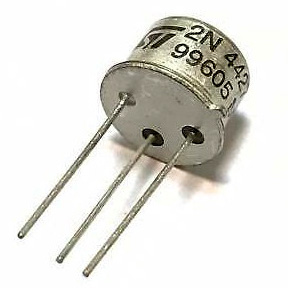 2N4427 (TO-39) | 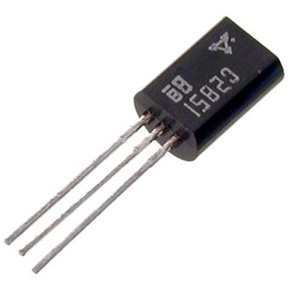 2SC2851 (TO-92) | 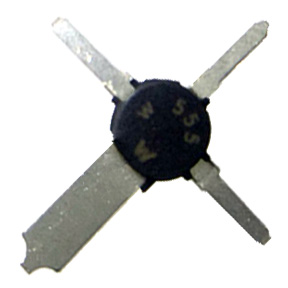 MRF555 (Power Macro) |
For standard, double sided, FR4 PCB material, the thermal characteristics of the PCB are such that it will rise around 500°C per Watt per square centimetre of board. Copper via's between the top and bottom of the board can help reduce this. Dissipating a half Watt of heat in a centimetre square of PCB will therefore raise the temperature of the PCB by up to 250°C which is far too hot a temperature for any transistor to operate. However, if the transistor is mounted on a bigger piece of PCB, the heat will be distributed over a wider area and it becomes possible to get rid of half a Watt of heat without being left with a device whose main purpose would be boiling tin.
 Given all the above, for the Wireless Waffle lockdown project, after scouring the planet for sources of 30 year old transistors, the decision was eventually made to use an MRF555 device. This has nice, healthy sized leads which can be soldered onto pads on a PCB and the heat will be distributed across the PCB from all four pins of the device. It's still readily available (though no longer manufactured), relatively cheap, and being a device designed for UHF use, it loafs along at VHF frequencies, making it more efficient and therefore producing less heat. When mounted on a PCB, producing a Watt of RF, it heats up to around 65°C which is hot to the touch, but won't damage the device (or your skin too badly if you touch it).
Given all the above, for the Wireless Waffle lockdown project, after scouring the planet for sources of 30 year old transistors, the decision was eventually made to use an MRF555 device. This has nice, healthy sized leads which can be soldered onto pads on a PCB and the heat will be distributed across the PCB from all four pins of the device. It's still readily available (though no longer manufactured), relatively cheap, and being a device designed for UHF use, it loafs along at VHF frequencies, making it more efficient and therefore producing less heat. When mounted on a PCB, producing a Watt of RF, it heats up to around 65°C which is hot to the touch, but won't damage the device (or your skin too badly if you touch it). add comment
( 86 views )
| permalink
| 



 ( 2.5 / 622 )
( 2.5 / 622 )




 ( 2.5 / 622 )
( 2.5 / 622 )
Saturday 5 June, 2021, 12:20 - Amateur Radio, Broadcasting, Licensed, Pirate/Clandestine, Electronics, Radio Randomness
Posted by Administrator
Posted by Administrator
 Hasn't lockdown been a bore? There is only so much Netflix or Amazon Prime that it's possible to watch, let alone enjoy. Mind you, having said that, and if you haven't already seen it, Halt And Catch Fire is a must-watch for any kind of nerd or geek who remembers the dodgy, unreliable and overheating computer designs of the early 1980s.
Hasn't lockdown been a bore? There is only so much Netflix or Amazon Prime that it's possible to watch, let alone enjoy. Mind you, having said that, and if you haven't already seen it, Halt And Catch Fire is a must-watch for any kind of nerd or geek who remembers the dodgy, unreliable and overheating computer designs of the early 1980s.In order to maintain some kind of sanity, in the Wireless Waffle workshop work has been proceeding on the crudely conceived idea of an instrument that will not only supply emissions for use in radio transmissions, but one which would also be capable of receiving them. Or to put it simply, a wideband VHF transmitter and a matching receiver which could be used as an audio link. Having designed and built many of these devices back in the 1990s, it ought to have been relatively straightforward to revisit those designs and modernise them. Alas, RF design is a fickle mistress and in addition to resulting in some truly awful designs, some very nice ones have also emerged. Along the way, many topics have had to be re-learnt all of which makes for some (very techy) content for a series of blog posts which may, in some small way, help those who might seek to replicate this pointless pass-time.
As Julio Iglesias once said, let's Begin (at) The Beg(u)in(e)(ning). There are dozens of designs for simple VHF variable frequency oscillators (VCO) on the internet, so getting something to generate the intial signals ought to be relatively straightforward. However, there is also lots of evidence to suggest that in cases where signals from oscillators are amplified to high power levels, and sent through antennas which are relatively close to the transmitter, radio frequency (RF) feedback can occur causing buzz and hum to the transmitted signal. The way around this is to have the oscillator work on a different frequency to the one being transmitted.
This might seem like an odd thing to do, however it is not uncommon. Two primary methods are used to achieve this:
- A variable oscillator is mixed with a fixed oscillator and the sum (or difference) of the two is then filtered and amplified. For example, a variable oscillator covering 100 to 125 MHz could be mixed with a fixed oscillator at 75 MHz, resulting in outputs either at 175 to 200 MHz (if the two signals are added) or 25 to 50 MHz (if the two are subtracted). The difficulty with this approach is that mixers are, almost by necessity, non-linear devices. In the first case, with the oscillator on 100 MHz, and the wanted output on 175 MHz, the second harmonic of the oscillator would fall at 200 MHz which, being within the 'wanted' output range, could not easily be filtered out. Careful selection of the variable and fixed frequencies can help overcome this, however this limits the possible range of output frequencies and also requires lots of filtering which is fine if the wanted frequency range is relatively narrow, but more difficult if the frequency range is wider.
- The varible oscillator operates at a frequency which is a sub-harmonic of the wanted frequency, and a multiplier is then used to double, triple or multiply the frequency by even higher orders. If we therefore wanted an output from 25 to 50 MHz, we could, for example, use an oscillator running from 8.33 to 16.66 MHz and triple it. Once again, multipliers are also non-linear devices and the 16.66 MHz signal would also be doubled to 33.33 MHz, which being within the wanted output frequency range would also be difficult to filter out. This method therefore is not without its problems and also requires filtering with all the issues associated with that.
Digging around the internet for 'Kalitron' circuits in which the double frequency (or '2f') output is available, yielded very few results. An article entitled, High Frequency VCO Design and Schematics by Iulian Rosu did discuss a Differential Cross-Coupled VCO and though Iulian's design is meant for very high frequencies, his article does provide some useful guidance. One of these is that the transistors should ideally be biased at the point between their saturation and linear regions (i.e. almost fully turned on). It was therefore decided to try and adopt this circuit.
Since getting involved in designing radio equipment in the 90s, the use of PNP transistors for oscillators has always been the preferred Wireless Waffle approach. The primary benefit of this is that the inductor used to set the frequency of the oscillator is grounded, making applying some kind of variable capacitance across it far easier. And so experimentation began. It would have been easy to copy the Veronica approach, however this requires 6 individual coils to be wound, and finding a simpler way to achieve the same results was sought. Getting such an oscillator to work was not difficult, but finding the correct balance of transistor current and bias, and then tapping off the doubled frequency component with sufficient 'oomph' to do something useful with, whilst not disturbing the oscillator's stability proved a complex balancing act. In addition, to keep the costs of the associated (and yet to be designed) phase locked loop (PLL) down by using off-the-shelf high speed CMOS chips also required a method to extract the un-doubled output to be found.
The final design works. Actually, that was meant to be the start of a sentence, but having got as far as 'the final design works', seemed sufficient.
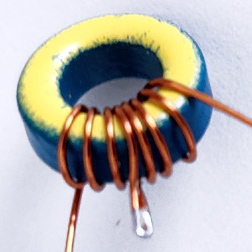 An inductor wound on a toroidal core was used for the oscillator, with a secondary winding (not shown in the picture) used to tap off the un-doubled output. This is somewhat fiddly to wind, but with practice becomes much easier and is the alternative to winding the 6 coils used in the Veronica design.
An inductor wound on a toroidal core was used for the oscillator, with a secondary winding (not shown in the picture) used to tap off the un-doubled output. This is somewhat fiddly to wind, but with practice becomes much easier and is the alternative to winding the 6 coils used in the Veronica design.Once oscillating a new issue was identified: the varicap diodes being used to tune the circuit were rectifying the RF generated by the circuit causing mountains of unwanted non-linear signals to be generated. This was partially fixed by not connecting the varicaps directly together but by short-circuiting them at RF with a capacitor whilst driving the DC level through separate resistors. Keeping the drive voltage above around 4 Volts keeps the diodes in their non-rectifying, more linear region though slightly reducing the potential tuning range. Reducing the amplitude of the oscillations would solve this a little but also reduce the potential output power. RF design is nothing if not a set of complicated compromises.
The doubled output from the oscillator is around 10 dBm (10 milliWatts) which is not quite enough to immediately drive a power amplifier to a reasonable level, so a buffer will be needed. The addition of a buffer will add (at a later date) the option to implement an 'out of lock power down' function in which the output of the transmitter is switched off until it has settled on the required frequency, without which a multitude of problems can occur.
The final circuit (or 'schematic' in American English) of the voltage controlled frequency-doubling oscillator (or 'uppy-downy-frequency-makey-matey' in Australian English) is shown below. Layout should be kept as symmetric as possible to minimise the amount of 'f' which is present on the '2f' output. The transistors used were originally type BF451 which are ideal for the task but other PNP RF transistors such as the BF509, BF939 or MPSH81 would work equally well.
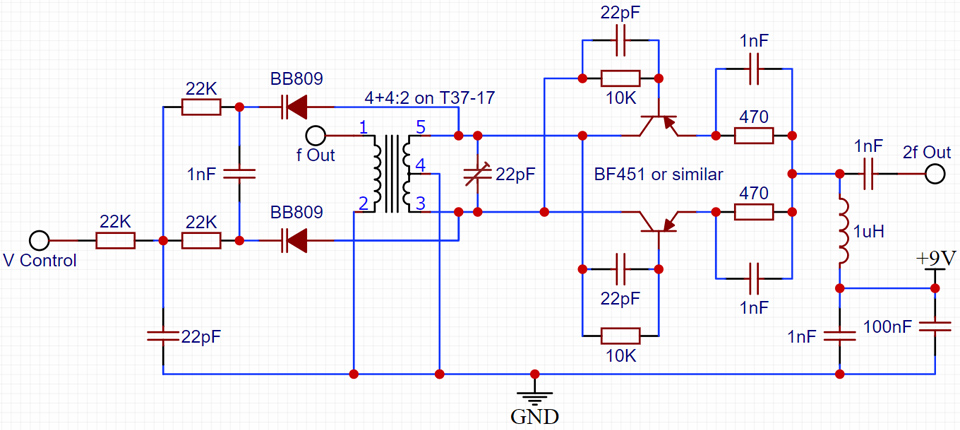
Future articles in this series may explore other unbelievably exciting topics such as:
- how not to blow up RF power transistors
- how well soldering irons burn things like skin and phone covers
- why 40 year old transistors trump modern ones
- glaringly obvious mistakes to make when sending PCBs for production
- forgetting that receivers are sensitive devices
- badly matching one stage to another
- getting PLL loop filters to oscillate wildly
- and much, much less...
There are currently over 100 satellites which transmit (either as their downlink, or as a beacon) in the 70 cm amateur band. The frequency range 432 - 438 MHz is internationally allocated to the Earth Exploration Satellite Service on a secondary basis, however most of the satellites generally use the amateur satellite allocation of 435 - 438 MHz.
Permission to use the amateur frequencies is given by footnote 5.282 of the frequency allocation table in the ITU Radio Regulations, which states:
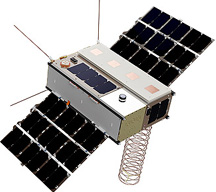 Wireless Waffle wanted to know if there was a particular hotspot within this frequency range where the majority of satellties were clustered, which would make it easier to set up a software radio (SDR) to search for these fleeting signals.
Wireless Waffle wanted to know if there was a particular hotspot within this frequency range where the majority of satellties were clustered, which would make it easier to set up a software radio (SDR) to search for these fleeting signals.
A bit of digging revealed a file containing all of the frequencies used by these satellites and some deft work with Excel formulas then revealed the answer to the question. And the answer is that the majority use frequencies between 437.2 and 437.6 MHz. Of the 176 active satellites frequencies analysed, 100 (or 57%) use frequencies in this range. So now you know and can sleep more soundly in your bed!
Permission to use the amateur frequencies is given by footnote 5.282 of the frequency allocation table in the ITU Radio Regulations, which states:
In the bands 435-438 MHz, 1 260-1 270 MHz, 2 400-2 450 MHz, 3 400-3 410 MHz (in Regions 2 and 3 only) and 5 650-5 670 MHz, the amateur-satellite service may operate subject to not causing harmful interference to other
services operating in accordance with the Table...
 Wireless Waffle wanted to know if there was a particular hotspot within this frequency range where the majority of satellties were clustered, which would make it easier to set up a software radio (SDR) to search for these fleeting signals.
Wireless Waffle wanted to know if there was a particular hotspot within this frequency range where the majority of satellties were clustered, which would make it easier to set up a software radio (SDR) to search for these fleeting signals.A bit of digging revealed a file containing all of the frequencies used by these satellites and some deft work with Excel formulas then revealed the answer to the question. And the answer is that the majority use frequencies between 437.2 and 437.6 MHz. Of the 176 active satellites frequencies analysed, 100 (or 57%) use frequencies in this range. So now you know and can sleep more soundly in your bed!
 Though it may have passed most of the international news channels by, the world's radio spectrum regulators and associated government departments and ministers have just signed away the results of the 2019 World Radiocomminication Conference (WRC-19) held in Sharm El Sheikh, Egypt. This 4 week long event is where international decisions on the use of the radio spectrum take place. Or at least that's the theory. All 'decisions' have to be driven by consensus, which means that everyone must agree and with so many divergent views on topics as wide ranging as more spectrum for 5G mobile services, to globally harmonising spectrum for railway communications, there is lots to discuss. There were around 20 items on the agenda for the conference.
Though it may have passed most of the international news channels by, the world's radio spectrum regulators and associated government departments and ministers have just signed away the results of the 2019 World Radiocomminication Conference (WRC-19) held in Sharm El Sheikh, Egypt. This 4 week long event is where international decisions on the use of the radio spectrum take place. Or at least that's the theory. All 'decisions' have to be driven by consensus, which means that everyone must agree and with so many divergent views on topics as wide ranging as more spectrum for 5G mobile services, to globally harmonising spectrum for railway communications, there is lots to discuss. There were around 20 items on the agenda for the conference.Of particular interest to radio amateurs was agenda item 1.1, which concerned:
the allocation of the frequency band 50-54 MHz to the amateur service in Region 1
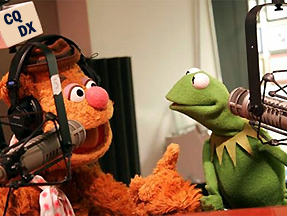 Radio amateurs have requested that the whole frequency range from 50 to 54 MHz is allocated to them on a primary basis in ITU Region 1 which is Europe, the Middle East and Africa. At present, in the ITU Radio Regulations, which dictate which frequencies are allocated to which services, 50 - 54 MHz is allocated to radio amateurs on a primary basis in Regions 2 (the Americas) and 3 (Asia/Pacific), and the idea was to align the band in every region. In Region 1 the frequencies are allocated to broadcasting as well as (in some countries) to radiolocation, land mobile and fixed (point-to-point) services, but not to radio amateurs (unless national administrations have unilaterally decided to allow them). Only in Botswana, Eswatini, Lesotho, Malawi, Namibia, the Democratic Republic of Congo, Rwanda, South Africa, Zambia and Zimbabwe does the band have any allocation to radio amateurs in the existing Radio Regulations.
Radio amateurs have requested that the whole frequency range from 50 to 54 MHz is allocated to them on a primary basis in ITU Region 1 which is Europe, the Middle East and Africa. At present, in the ITU Radio Regulations, which dictate which frequencies are allocated to which services, 50 - 54 MHz is allocated to radio amateurs on a primary basis in Regions 2 (the Americas) and 3 (Asia/Pacific), and the idea was to align the band in every region. In Region 1 the frequencies are allocated to broadcasting as well as (in some countries) to radiolocation, land mobile and fixed (point-to-point) services, but not to radio amateurs (unless national administrations have unilaterally decided to allow them). Only in Botswana, Eswatini, Lesotho, Malawi, Namibia, the Democratic Republic of Congo, Rwanda, South Africa, Zambia and Zimbabwe does the band have any allocation to radio amateurs in the existing Radio Regulations.Following the machinations at WRC-19, the radio amateurs have been granted a secondary allocation across Region 1 in the frequency range 50 - 52 MHz, with primary allocations in some or all of the range 50 - 54 MHz in a limited number of new countries. A secondary allocation means that the amateurs must not cause interference to any primary services (i.e. broadcasting and land mobile) and must accept interference from them, but it's a step forwards towards a global expansion of the 6 metre band.
This does not mean that the band will be available in each and every country immediately. First, each country's administration or regulator needs to update their national frequency allocation table to include the new band. This can take anything from a few months to a few years. There are still some countries who have not yet implemented the results of the previous WRC in 2015, despite it being completed 4 years ago. So don't hold your breath hoping to use the band when on holiday in Ouagadougou, it may be a long time before this new band is widely available.
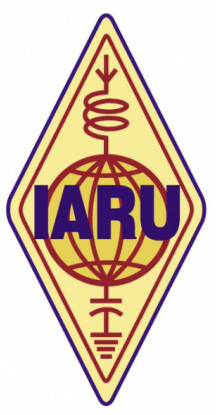 The next task for the International Amateur Radio Union (IARU) who work tirelessly on behalf of radio amateurs at events such as WRC-19 is to deal with Agenda Items 1.2 and 9.1.2 of the next WRC in 2023. Agenda Item 1.2 is entitled:
The next task for the International Amateur Radio Union (IARU) who work tirelessly on behalf of radio amateurs at events such as WRC-19 is to deal with Agenda Items 1.2 and 9.1.2 of the next WRC in 2023. Agenda Item 1.2 is entitled:to consider identification of the frequency bands ... 10.0-10.5 GHz for International Mobile Telecommunications (IMT), including possible additional allocations to the mobile service on a primary basis... (N.B. this applies in Region 2, i.e. the Americas, only)
This includes a secondary Amateur allocation between 10.0 and 10.5 GHz, and a secondary Amateur-Satellite allocation between 10.45 and 10.5 GHz (as used by the already infamous Es'Hail-2 (a.k.a. QO-100), the first geostationary satellite with an Amateur radio transponder. Whilst the allocation of the band for IMT (5G) services does not preclude the Amateur service, in reality, a band full of a dense network of base stations and handsets would make it nigh-on impossible to be used for amateur radio and the band may be lost, in exactly the same way that the 2.3 GHz and 3.4 GHz bands were.
Agenda Item 9.1.2 is entitled:
Review of the amateur service and the amateur-satellite service allocations in the frequency band 1 240-1 300 MHz to determine if additional measures are required to ensure protection of the radionavigation-satellite (space-to-Earth) service operating in the same band...
 The IARU will need to stave off pressure to remove (or otherwise reduce) the radio amateur secondary allocation on the frequencies 1240 - 1300 MHz (the 23 cm band) as it is claimed by the European Commission that amateurs may cause interference to their Galileo satellte navigation system. Not, it is worth pointing out, the everyday service used by smart phones and in-car sat-navs, but an additional service for specialist users.
The IARU will need to stave off pressure to remove (or otherwise reduce) the radio amateur secondary allocation on the frequencies 1240 - 1300 MHz (the 23 cm band) as it is claimed by the European Commission that amateurs may cause interference to their Galileo satellte navigation system. Not, it is worth pointing out, the everyday service used by smart phones and in-car sat-navs, but an additional service for specialist users.  The argument goes that there was once an amateur television repeater in the band which caused interference. Once - and it was resolved very quickly. But that is enough to raise concerns of potential wider future interference problems. The Commission therefore want to throw the amateurs out of the spectrum. The amateur allocation is secondary, so they must not cause interference, and so the Galileo service is already protected, but that is not always enough for everyone. The ITU giveth with one hand, and threaten to take away with two others. Was it ever any different?
The argument goes that there was once an amateur television repeater in the band which caused interference. Once - and it was resolved very quickly. But that is enough to raise concerns of potential wider future interference problems. The Commission therefore want to throw the amateurs out of the spectrum. The amateur allocation is secondary, so they must not cause interference, and so the Galileo service is already protected, but that is not always enough for everyone. The ITU giveth with one hand, and threaten to take away with two others. Was it ever any different?

